Try Amazon Audible Plus

Shop Amazon - Create an Amazon Baby Registry

Part 4: The artillery
by George Gush
GUNS WERE ALREADY essential for siege warfare, and although they were slow-firing and very immobile they had also been successfully employed on the battlefield before the 16th century, notably in the wagon-riding Czech armies of Jan Ziska, and by the French in the later stages of the 100 Years War. Early cannon were usually on static mountings, and a crane, for lifting, and wagons, for transport, remained essential parts of the artillery train well into the 16th Century (in 1527 the Emperor Maximillian still had six heavy guns like this, though his 105 lighter guns were all on wheeled carriages). Among the first guns on wheeled carriages were those used by the French in 1461, and those which the Swiss captured from Charles the Bold of Burgundy in the 1470s (and still hold).
Up to about the beginning of the 16th Century gun barrels had no trunnions and had to be strapped to their carriages with iron bands, thus elevation had to be achieved by providing some way of tilting the carriage including digging one end into the ground), and many early 16th Century guns were like this, though the introduction of cast-on trunnions produced a more modern type of carriage for some guns, the barrel being raised or lowered independently, usually by means of wedges inserted under the breech end with a handspike.
In the 15th Century many large guns were of built-up construction, with wrought-iron bars and rings welded together, and siege-guns of this type were still used in the early 16th Century - they were often breech-loaders with a separate chamber which had to be wedged at the rear of the barrel; however the great majority of the guns of this period were cast bronze muzzle loaders (the bells of a captured city were often reserved to the master-gunner for their construction). By the 1540s cast iron guns were successfully produced in Sussex, and later were made in Sweden and Holland as well: they were only one-quarter the price of bronze guns, but were a lot heavier and were regarded with grave suspicion owing to their habit of bursting without warning (if a bronze gun did burst, it usually showed a tell-tale bulge first).
The first fully mobile and effective field artillery appeared in 1494 in the train of Charles VIII of France when he invaded Italy, and Fornovo (1495) was probably the first battle where artillery played a really effective part. The eight-foot bronze guns were drawn by horse teams and could keep up with marching infantry. They made a great impression on the Italians whose few heavy pieces, being ox-drawn, usually arrived too late for battles and, according to Machiavlli, could never fire more than one or two shots before battle was joined. The Spanish defeat at Ravenna (1512) was largely due to the French train of 30 guns, plus another 24 belonging to their ally the Duke of Ferrara, and the Spanish themselves on this occasion fielded 20 pieces. There was a great variety of guns in use (Henry VIII used no less than 11 different calibres at his siege of Boulogne), and an even greater variety of names very imprecisely applied to them by writers of the time, but a number of basic types can be distinguished by the mid-16th Century. The cannon was a wide-bore, short gun (Sir James Turner in Pallas Armata said cannon were 'not above 18 or 19 diameters of their bores in length') intended for smashing down walls at a range, preferably, of only 200 yards or so: culverins, were longer, higher velocity weapons of longer range, and most field guns-fell into this category; mortars and perriers were short-barrelled high-trajectory weapons, mainly for siege work; and there were also various 'Ribauldquins', organ-guns, 'shrimps', 'carts of war' and so on: basically these last were multiple guns mounted on a common carriage. sometimes with some form of protection for the crew; shrimps were really siege weapons with a couple of light guns, organ guns could have as many as 36 barrels and were a sort of forerunner of the machine gun, while several variations on the light-cart-with-heavy arquebuses theme around the mid-16th Century seem to have been intended more as light artillery for the close support of infantry. Multiple guns were used as late as the English Civil War, 'two barricades drawn on wheels, in each seven small brass and leathern guns charged with case shot' being captured by the Royalists in 1644.
There were attempts at standardisation during the 16th Century, the earliest being by Charles V, who in 1544 ordered the following to be the standard types in Imperial and Spanish armies:
40 pounder Cannon
24 pounder Cannon Moyane
12 pounder Culverin (2 types of different lengths)
6 pounder Culverin (2 types of different lengths)
3 pounder Falcon
In 1550 Henri II instituted the famous 'Six Calibres of France' of which some details are given as follows:
33 pounder Cannon; 10 ft 6 in long; team 22 horses.
15 pounder Culverin; 11 ft long; team 17.
7 pounder Bastard Culverin; 11 ft; team 11.
2 pounder Culverin Moyane; 8 ft 6 in; team 4.
1 pounder Falcon; 7 ft 6 in long; team 3.
¾ pounder Falconet; 7 ft long; team 2.
Later efforts in this direction were probably rather more successful - Maurice of Nassau reduced the guns of the Dutch army to four types at the end of the century (48, 24, 12 and 6 pounders), and Gustavus Adolphus limited the Swedish Artillery to 24, 12 and 6 pounders, plus infantry gun, which were 3 or 4 pounders.
Some general information on guns of the time is summarised in the table.
Table of Ordnance
Piece Weight Shot Bore Length Ranges (yds)
lb lb in ft Point Blank At 10 deg Maximum
CULVERIN TYPE
Esmeril, rabinet 200 0.3 1.0 2.5 200 - 750
Robinet 200 1 1.25 - 200 - -
Serpentine 250-400 0.5 1.5 3.0 250 - 1,000
Falconet 500 1-2 2.0 3.7-6 280 - 1,500
Bombard (1512) 600 - 3.5 9.0 - - -
Falcon 800 3.0 2.5 6-7 320-400 1,920 2,500
Minion, Demi Saker 1,000-1,100 4.5-6 3-3.3 6.5-8 450 - 3,500
Passe Volant 3,000 6.0 3.3 10.0 - - 4,500
(also name of smaller gun)
Saker 1,500-1,600 5.5-9 3.25-4 7.0 360-500 2,170 4,000
Culverin Bastard 2,299-3,000 12 4.6 8.5 600 - 4,000
Demiculverin 3,000-3,400 10 4.2-4.5 8.5 400-850 2,400 5,000
Culverin 4,000-4,800 15-19 5.2-5.5 11.0 460 4,000 6,700
Culverin Royal 7,000 32 6.5 16.0 2,000 - 7,000
CANNON TYPE
Quarter Cannon 2,000 12 4.6 7.0 400 - 2,000
Demicannon 4,000 24-36 6-6.5 11.0 450 - 2,500
Bastard or
Spurious Cannon 4,500 42 7.0 10.0 400 - 2,000
Cannon Serpentine 6,000 42 7.0 12.0 500 - 3,000
Cannon 7,000 50 8.0 13.0 600 - 3,500
Cannon Royal Curtowe 8,000 60 8.5 8.5-12.0 750 - 4,000
Double Courtant 7,300 80 11.0 - - - -
Basilisk 12,000 90 10.0 10.0 750 - 4,000
MORTARS Etc
Cannon Perier 3,000 24.5 - - - - 1,600
Pedrero (medium) 3,000 30 10.0 9.0 500 - 2,500
Mortar (medium) 1,500 30 6.3 2.0 300 - 750
Mortar (heavy) 10,000 200 15.0 6.0 1,000 - 2,000
Even on wheeled carriages, the guns of the period had very limited mobility, only partly because of the dreadful roads; a Scottish 'Great Culverin' of 1513 required no less thin 36 oxen, and English Culverins of the Civil War needed nine horses. 16th Century wheeled guns were sometimes dragged barrel-first, with the trail literally trailing. Otherwise a pair of shafts was normally attached to the trail and the strongest horse harnessed between them, the other horses or oxen being harnessed ahead of it on traces, either in pairs or in tandem. The limber, in the form of a pair of wheels pivoted benefit the trail of a gun, came into use in the 16th Century, in the Spanish and Imperial forces (and, under Maurice of Nassau, in Holland) at least, but doesn't seem to have been used everywhere; certainly it hadn't spread to England by the time of the Civil War.
Ammunition for immediate use was sometimes carried in a pentroofed chest on the gun trail by the late 16th Century, but separate ammunition carts were more usual. Drivers and teams tended to be temporarily hired civilians of limited enthusiasm, except in the Turkish army, which already had a regular drivers' corps, the 'Top Arabacis', 3,000 strong. These Turks walked beside their teams, perhaps because the Turks favoured heavy and rather immobile guns which were probably mostly ox-drawn, but 16th Century European drivers are often depicted riding the left-hand horses of their teams. Very light guns some-times had a trail consisting of two shafts - a 15th Century example is shown - and similar carriages were in use up to the end of the 17th Century.
Organisation
Normally, all the artillery of an army would form a single Train under a Master-General of the Ordnance (Topji-Pasha in the case of the Turks) who would also be responsible for deploying them in battle. The first separate artillery units I have come across were the regiments formed in the Swedish artillery by Lennart Torstensson, Gustavus Adolphus' 27-year-old artillerist; each had six Companies, four of gunners, one of engineers and one of pioneers. In the English Civil War a demi-cannon (about the heaviest piece ever used in the field) had a crew of three gunners and six matrosses (gunners mates); a culverin two gunners and four matrosses, lighter guns down to three men. A Royalist Artillery Train had 275 carters, 200 pioneers and 44 'conductors' to 69 gunners, and 88 matrosses; these would probably be fairly average proportions.
The Turks liked to mass their guns in line, often chained together and sometimes placed in reserve behind a line of cavalry to engage any enemy breaking through; tactics which proved very successful against the Persians at Chaldiran (1514) and the Hungarians at Mohacs (1526).
Among European armies guns would probably be placed to the rear of an army if suitable high ground was available, often scattered at 50 or 100 yard intervals. Concentration of guns to fire on a decisive point was unusual, probably because only the lightest had any tactical mobility, the rest having to stop in their pre-battle positions; however it did sometimes happen - for example at Cheriton in the English Civil War where the Royalists concentrated their guns to support their attack on Cheriton Wood.
Most often, throughout the period, guns were drawn up in front of the army, which seems to imply that they were expected to play their main role before the armies moved to join battle. Very light, mobile guns which could accompany advancing infantry appeared by the 17th Century; they are usually attributed to Gustavus Adolphus, but I think that some of the very light guns employed earlier must have been used in a similar way. Other armies, including the Roundheads and the Scots Covenanters, followed the Swedes in attaching such weapons to infantry units.
A very effective tactic in the early 16th Century, used by the French in Italy and also by the Teutonic Knights, was to stop and pin enemy forces by a series of controlled cavalry charges, so that artillery fire could destroy them.
Effectiveness
Artillery was decisive in some battles, such as Marignano (1515) and Pinkie (1547) and was always useful except in very difficult terrain such as that of Ulster, and nearly all European and Middle Eastern armies of the period employed as much as they could afford. Accuracy was very limited over about 300 yards (¼ inch windage was allowed between shot and bore) and rates of fire were not high, probably because guns were loaded with shovelfuls of loose powder from a barrel (usually closed with a leather cover with a drawstring). Cartridges, though known, were not apparently used much until the advent of Gustavus's regimental guns, which, using them, achieved rates of fire of up to three rounds a minute - faster than a musket. William Eldred, in The Gunners' Glasse (1646) gave eight rounds per hour as the average, though other evidence seems to show that quite large 17th Century guns such as culverins could manage ten rounds an hour; 'Drakes' (guns under 5 pounders) of the same period achieved 15 rph. For safely, a gun was supposed to fire only a limited number of shots per day, or at least before having a cooling-down period (for example, a 20 pounder culverin of Henry VIII was limited to 36 rounds a day). The usual missile was an iron cannon ball, though enormous stone shot were still favoured by the Turks; case-shot (lead balls in a canister) is first recorded from 1410, and was used at close range against attacking troops, especially by light and multiple guns; chain shot was used in special circumstance (for example to sweep troops off a breach) and mortars already used explosive shells, though this could he a highly dangerous business.
The very deep infantry formations common in the 16th Century probably made very good targets for artillery, cannon balls ploughing through several ranks at a time and another useful effect was the frequent 'stinging' of not over-disciplined troops into disastrous attacks by steady artillery fire. Field fortifications, and lying down, were employed to counteract artillery fire.
Illustrations
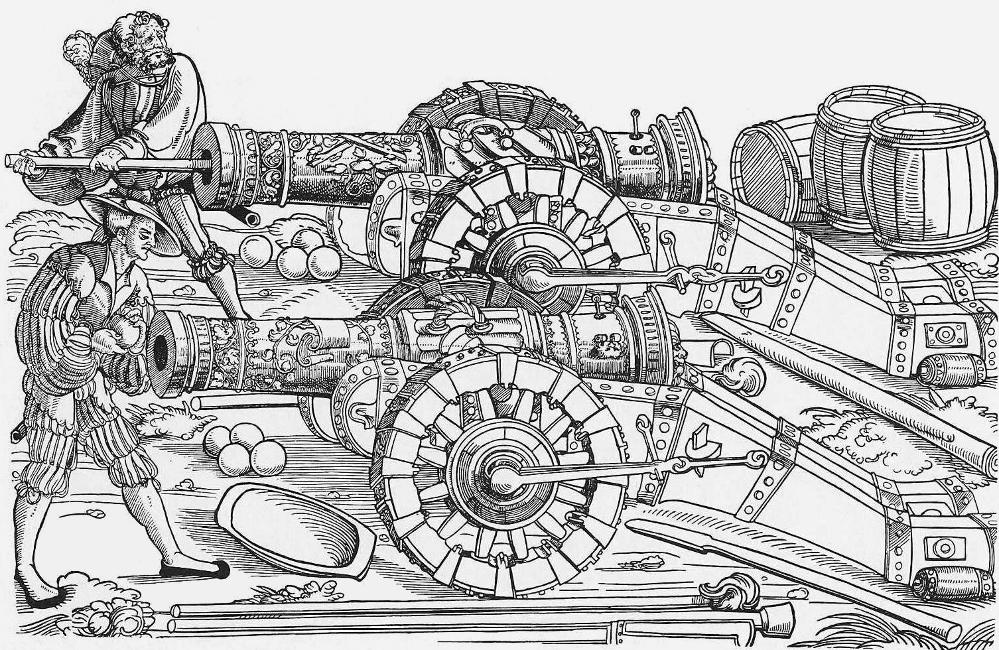
German 16th Century field guns with gunners' implements. Note lavish decoration on barrels! From a woodcut by Erhardt Schoen (1514-1550).
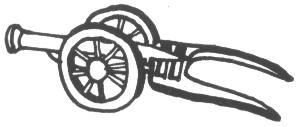
A light field gun with shafts on carriage of the later 15th Century (sketch by author).
[Based on f.54v, British Library MS Royal MS 18 E V. Southern Netherlands, 1473 to 1479.]
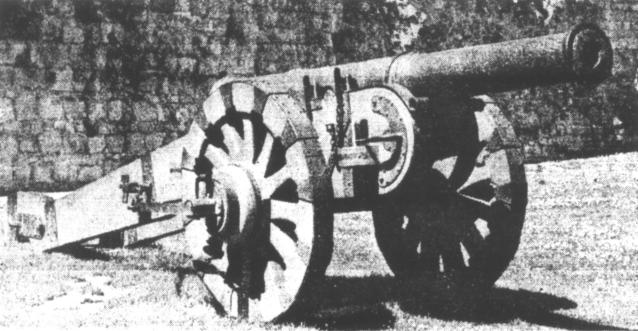
A culverin of 1588 on replica carriage, preserved at Pevensey Castle, Sussex.
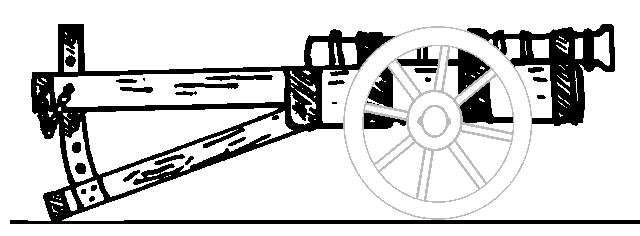
Sketch showing elevating carriage for gun without trunnions, late 15th Century.

17th Century Saker with early type of limber (Miniature Figurines gun and limber).
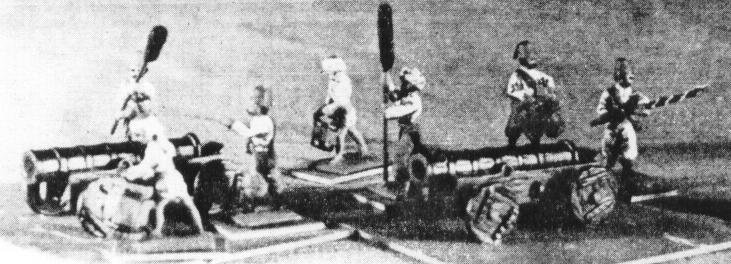
Turkish heavy guns of the early 16th Century (Miniature Figurines guns with gunners converted from Egyptian Campaign and Colonial ranges).








